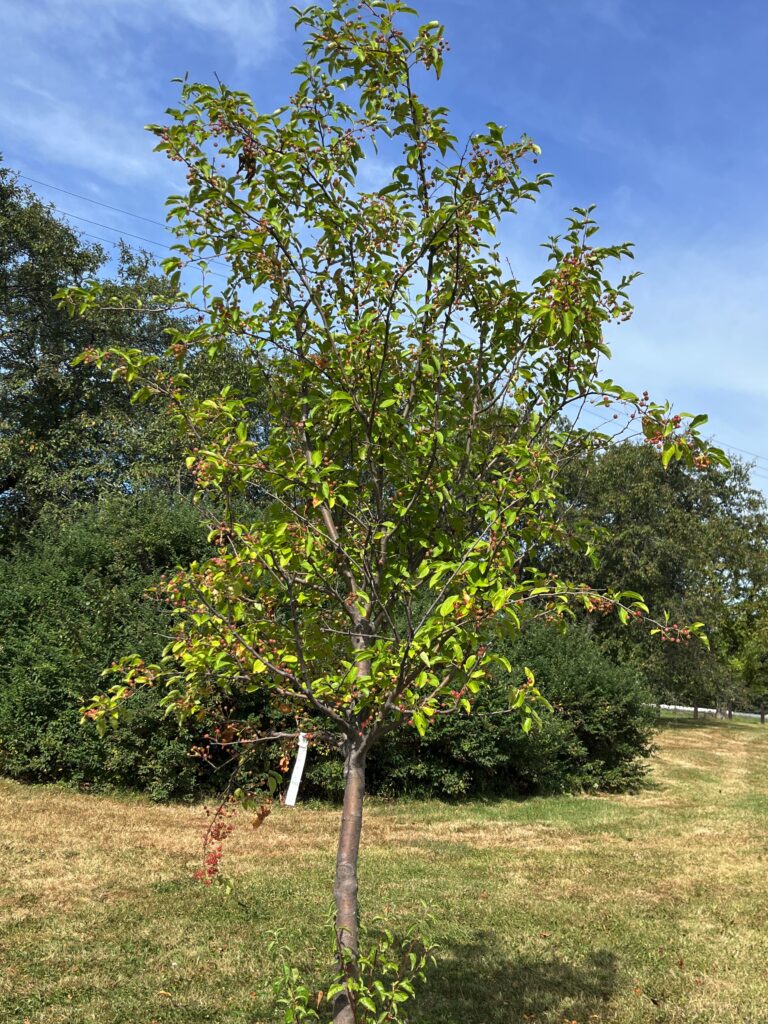2025 CelebriTrees Available for Sponsorship
American Hornbeam
Amur Chokecherry
Autumn Treasure Ironwood
Bur Oak (1)
Bur Oak (2)
Dawn Redwood (1)
Dawn Redwood (2)
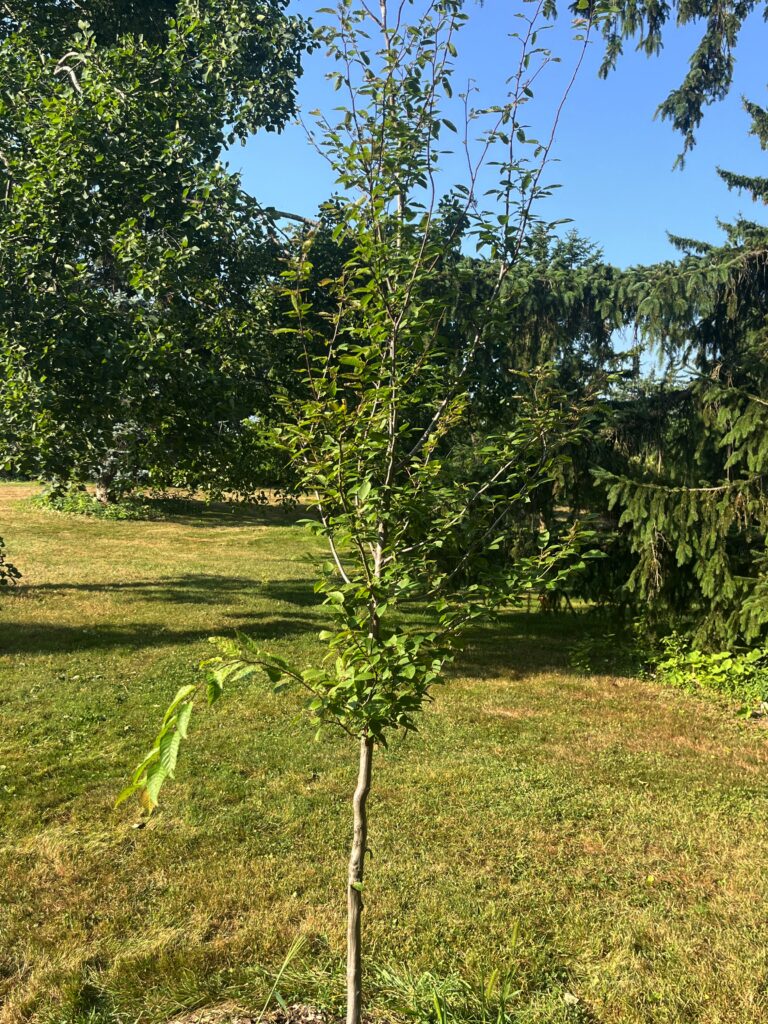
American Hornbeam—Carpinus caroliniana—This tree is an understorey tree that is native to Ontario and southwest Quebec. The bark is smooth, and on mature trees it’s fluted as if rippling with muscles. This trait leads to other names for the tree, such as Blue-beech and Musclewood. The American Hornbeam tree has an attractive round or flat-topped form. The tree can grow to 10 metres tall. This tree is located next to the Arboretum circle road, nearly across from a path leading down into the wooded area of the Arboretum.
Amur Chokecherry—Prunus maackii—Amur Chokecherry grows along the banks of the Amur River and neighbouring parts of Asia. It is prized especially for its peeling cinnamon-coloured bark, which stands out even from a distance. The tree also has small fragrant white flowers and black berries that attract birds. Amur Chokecherry is very cold hardy. The tree can grow to 10 metres tall. This tree is located by the fence at the top of the slope, heading down the hill and about 5 metres east of where the south path intersects the Arboretum circle road.
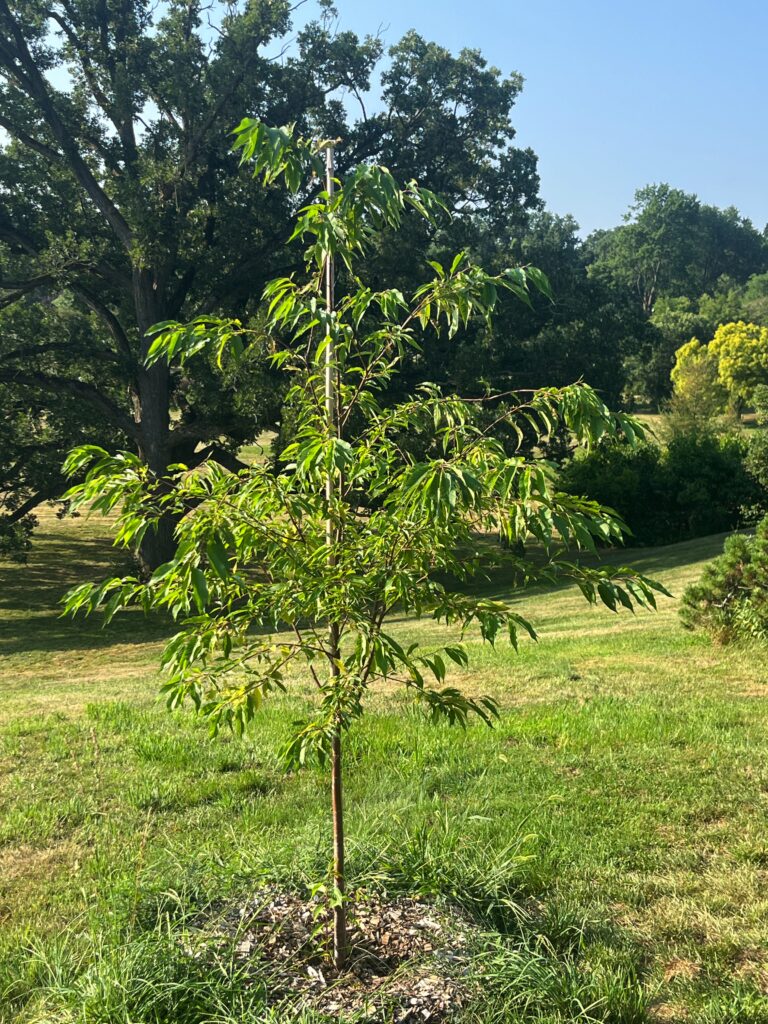
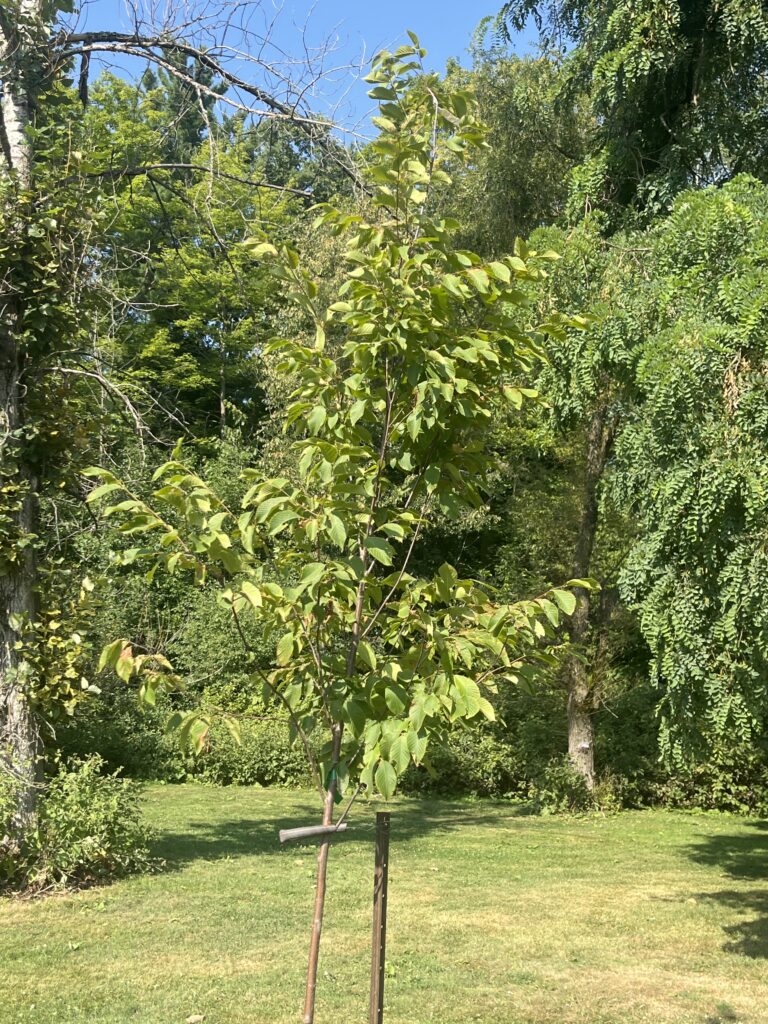
Autumn Treasure Ironwood—Ostrya virginiana ‘Autumn Treasure’—Ironwood is a sturdy understorey tree found regularly in the forests around Ottawa. Having no serious pests or diseases, it deserves to be planted more in the city. Its hanging flowers are called catkins, and they develop into hop-like fruits that bear little nutlets sought by birds and other animals. Autumn Treasure is a narrow form of the species, with golden fall colour. The tree can grow to 15 metres tall. This tree is located along the lowland path, about 30 metres southeast of a very large old bur oak.
Bur Oak (1)—Quercus macrocarpa—Bur Oak is a stalwart component of the local forest as well as the urban landscape. It’s been planted in Ottawa’s parks and streets for many years despite its large girth and height. The species grows from New Brunswick to as far west as Alberta, the biggest range of our native oaks. Like other oaks, it is a source of shelter and food for many kinds of wildlife. The tree can grow to 25 metres tall. This tree is located on the east side of the lowland path, about 30 metres southeast of a very large old bur oak.
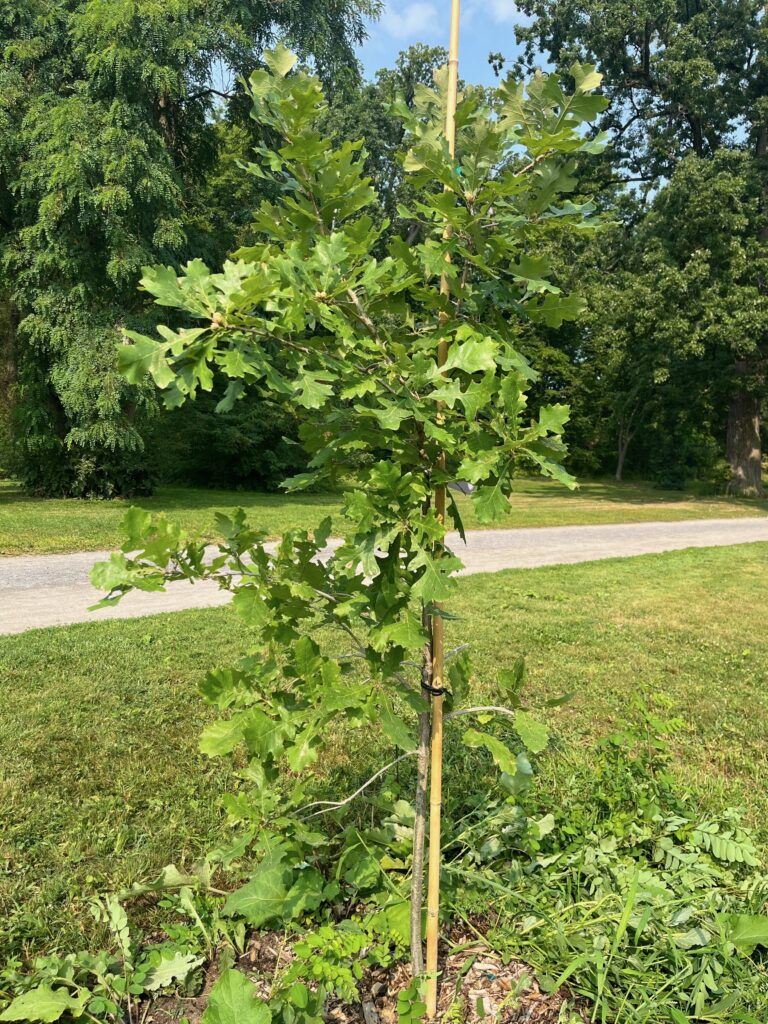
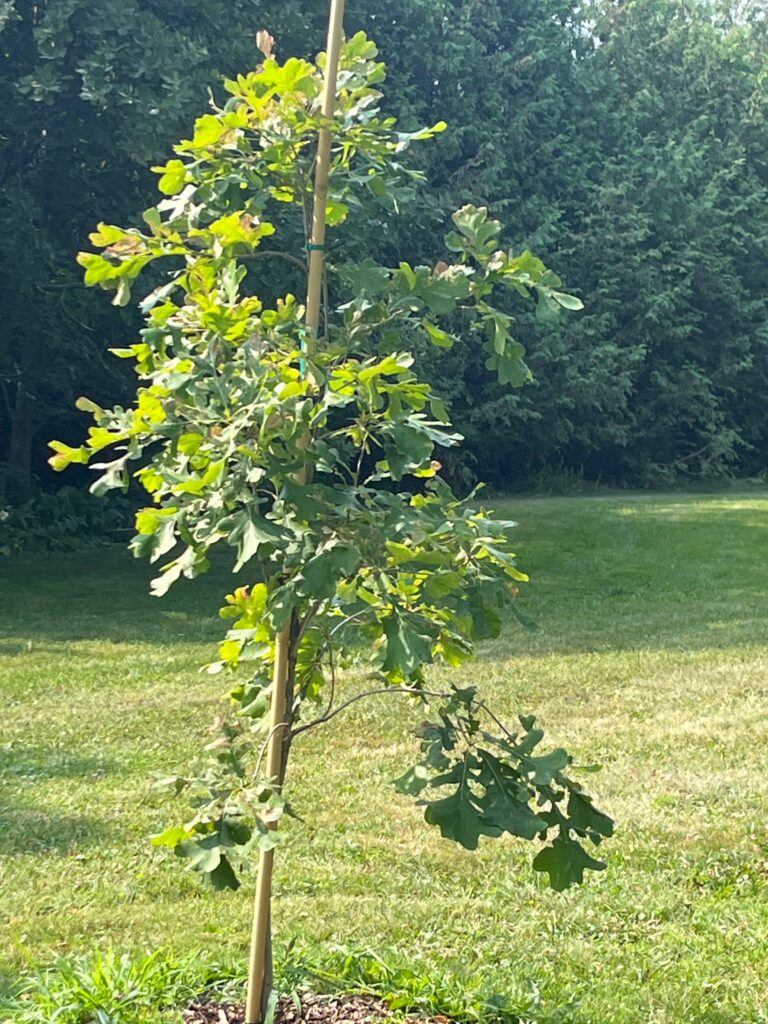
Bur Oak (2)—Quercus macrocarpa—Bur Oak is a stalwart component of the local forest as well as the urban landscape. It’s been planted in Ottawa’s parks and streets for many years despite its large girth and height. The species grows from New Brunswick to as far west as Alberta, the biggest range of our native oaks. Like other oaks, it is a source of shelter and food for many kinds of wildlife. The tree can grow to 25 metres tall. This tree is located about 20 metres west of the Fletcher Wildlife Garden parking lot entrance to the Arboretum.
Dawn Redwood (1)—Metasequoia glyptostroboides—This unique genus is closely related to the Giant Sequoias and Redwoods found in California and, although fossils can be found throughout the northern hemisphere, living specimens were only discovered in China in the 1940’s. It was then introduced to gardens around the world. The tree has a pyramidal shape and attractive feathery foliage that turns reddish brown in the fall. Although the tree can reach 45 metres in a rainforest, in Ottawa it will grow to no more than 25 metres tall. This tree is located in the northern part of the Arboretum, about 30 metres east of a bench.
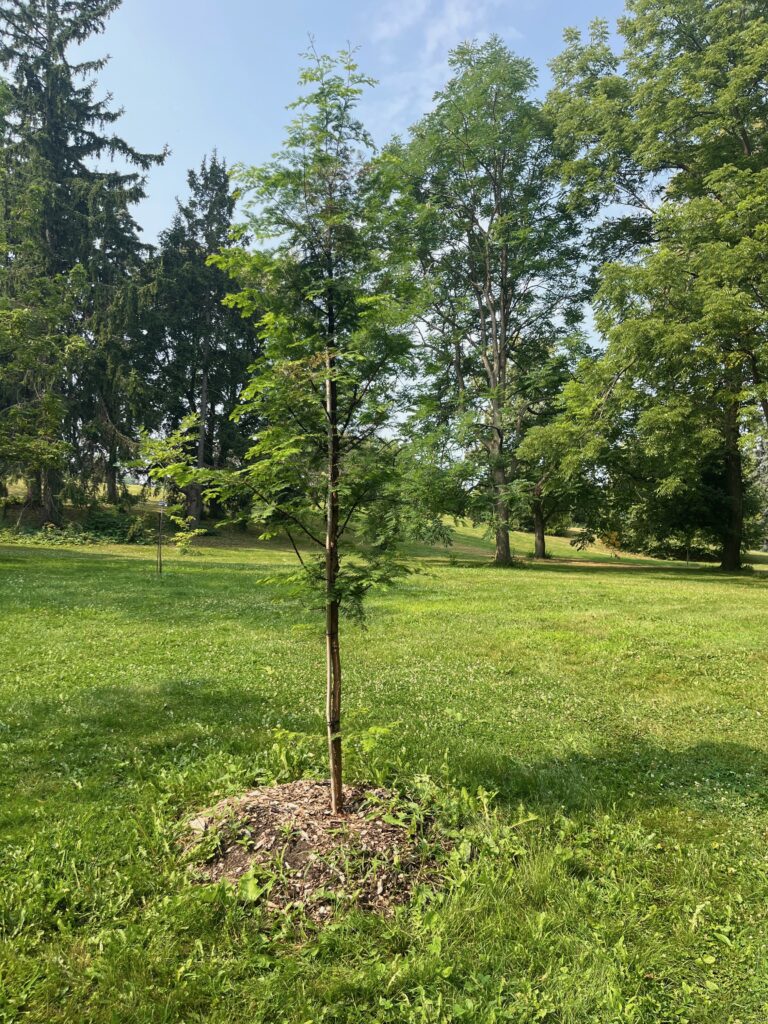
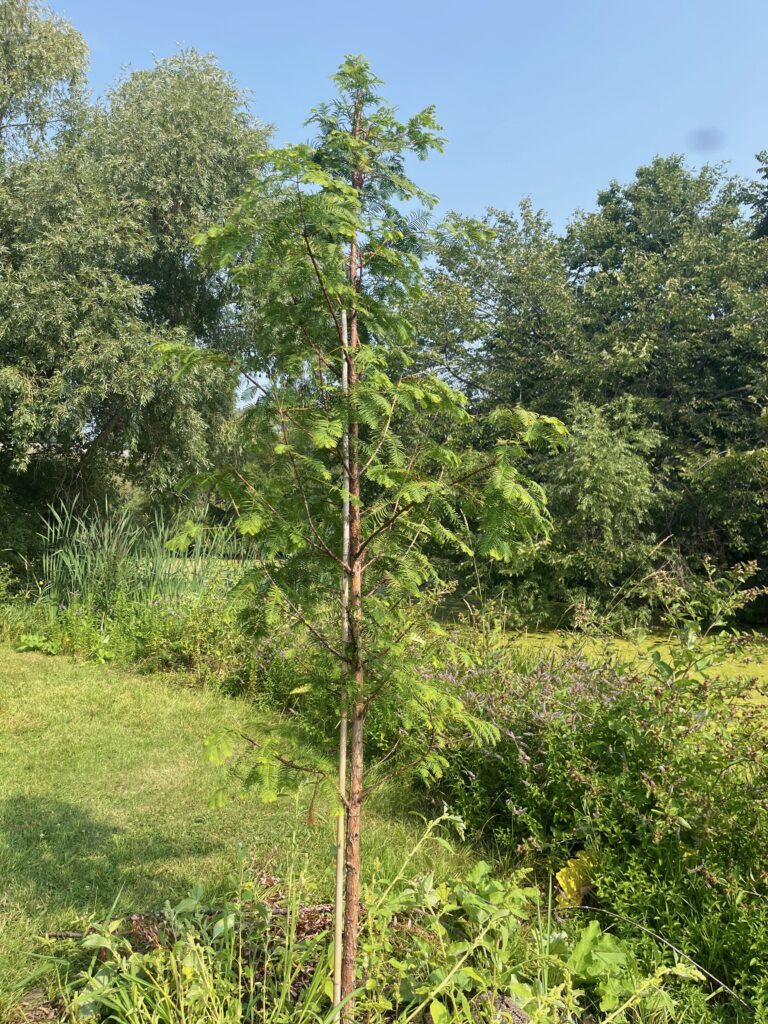
Dawn Redwood (2)—Metasequoia glyptostroboides—This unique genus is closely related to Giant Sequoias and Redwoods found in California and, although fossils can be found throughout the northern hemisphere, living specimens were only discovered in China in the 1940’s. It was then introduced to gardens around the world. The tree has a pyramidal shape and attractive feathery foliage that turns reddish brown in the fall. Although the tree can reach 45 metres in a rainforest, in Ottawa it will grow to no more than 25 metres tall. This tree is located on the northeastern tip of Heart Island, reached by a small bridge on its south end.
English Oak—Quercus robur—Although called English Oak, this tree is native to most of Europe and western Asia and is revered for its strength and longevity. The crown of the mature tree is widespread and imposing with long, large branches. English Oak is long-lived and provides shelter and food for many types of wildlife, including insects, birds, and small mammals. The tree can grow to 25 metres tall. This tree is located on the south path, about 30 metres north of the large fenced-in Bebb’s Oak.
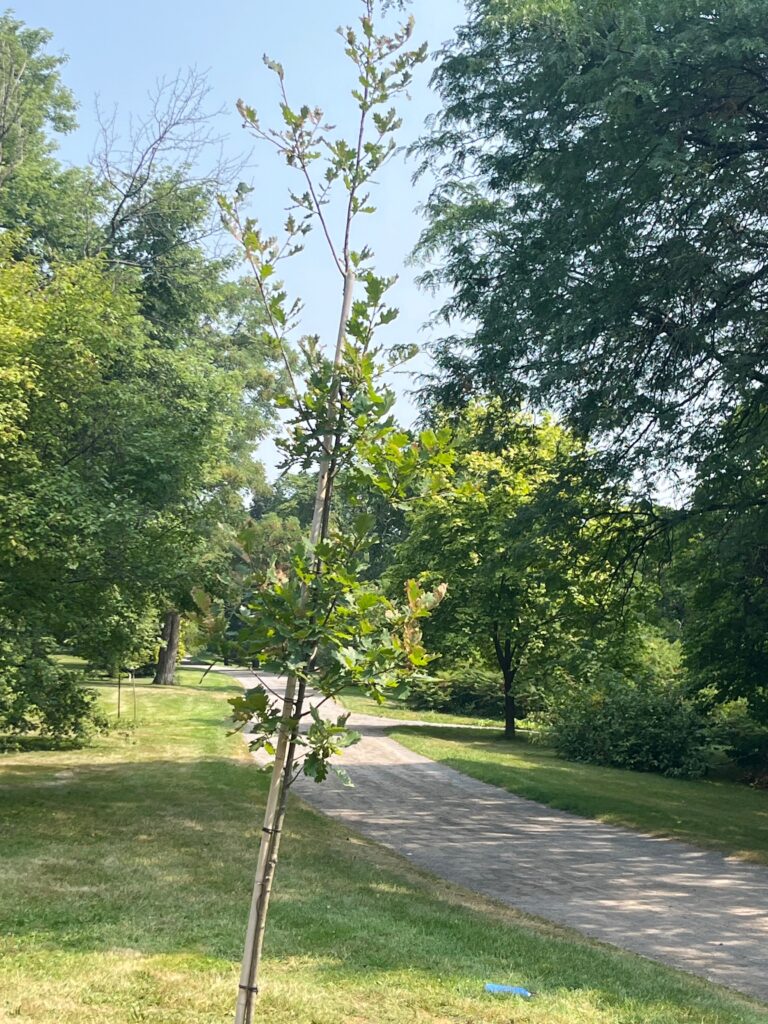
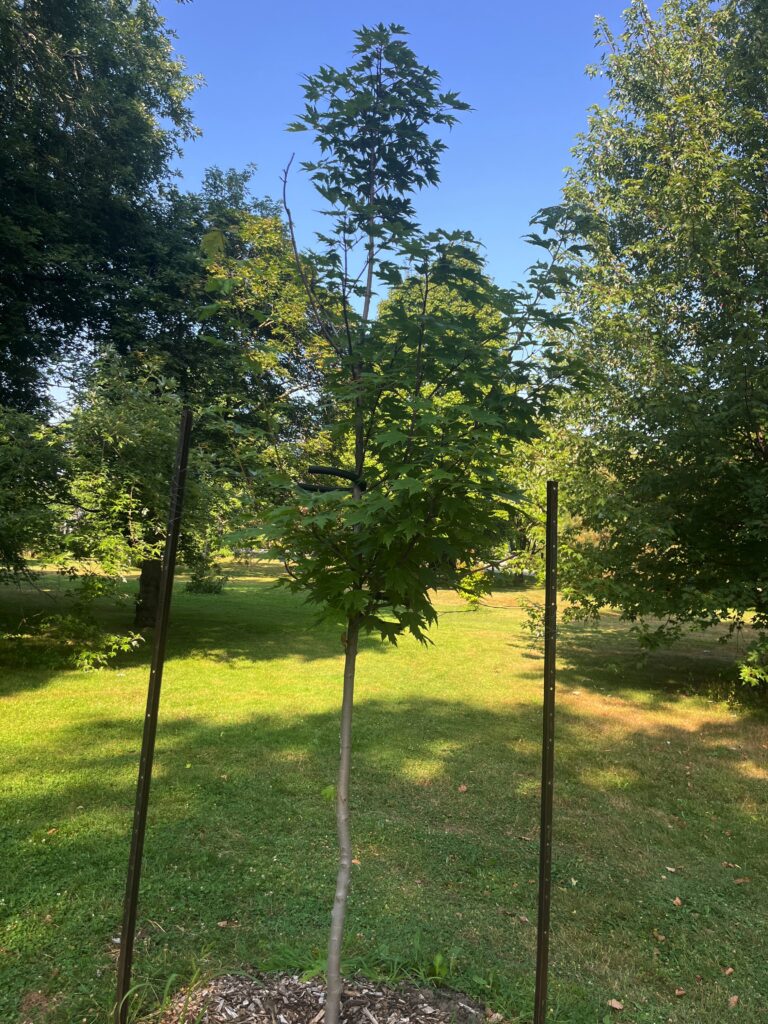
Firefall Maple—Acer x freemanii ‘Firefall’—Freeman Maples are hybrids of Red and Silver Maple species, exhibiting some attributes of both species. Red and Silver Maples hybridize naturally, but Freeman Maples are controlled for desired traits. This Firefall cultivar has a strong open crown and is reported to be tolerant of difficult soils and climate conditions. The leaves turn a striking orange red in the fall. The tree grows to about 15 metres tall. This tree is located amongst other maple trees, 30 metres south of the entrance road and about 30 metres west of the Arboretum circle road.
Imperial Honey Locust—Gleditsia triacanthos ‘Impcole’—Honey Locust has become a very popular street tree worldwide due to its graceful open crown of fine leaflets and its tolerance of many urban problems including drought and salt spray. Although the wild species has formidable thorns growing out of its trunk and branches, the varieties sold by nurseries (including this one) are thornless. The Imperial cultivar has a very regular growth habit with branches that emerge at right angles from the trunk. The tree can grow to 20 metres tall. This tree is located very close to the intersection of the Arboretum’s south path with the downhill path that heads to the east.
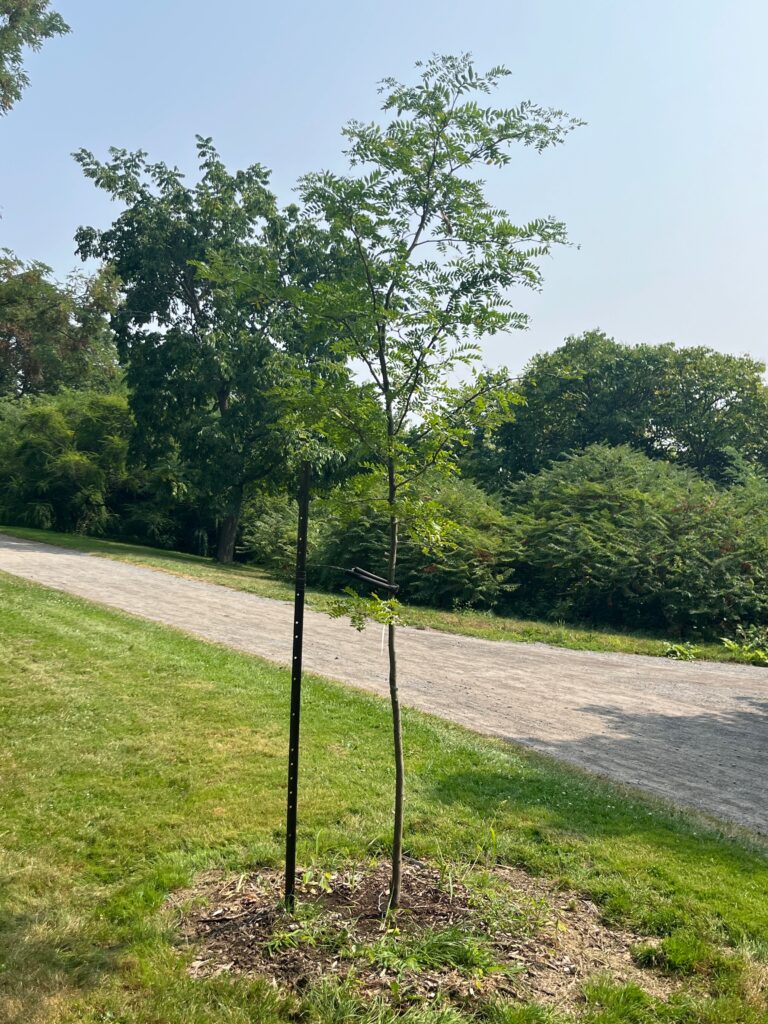
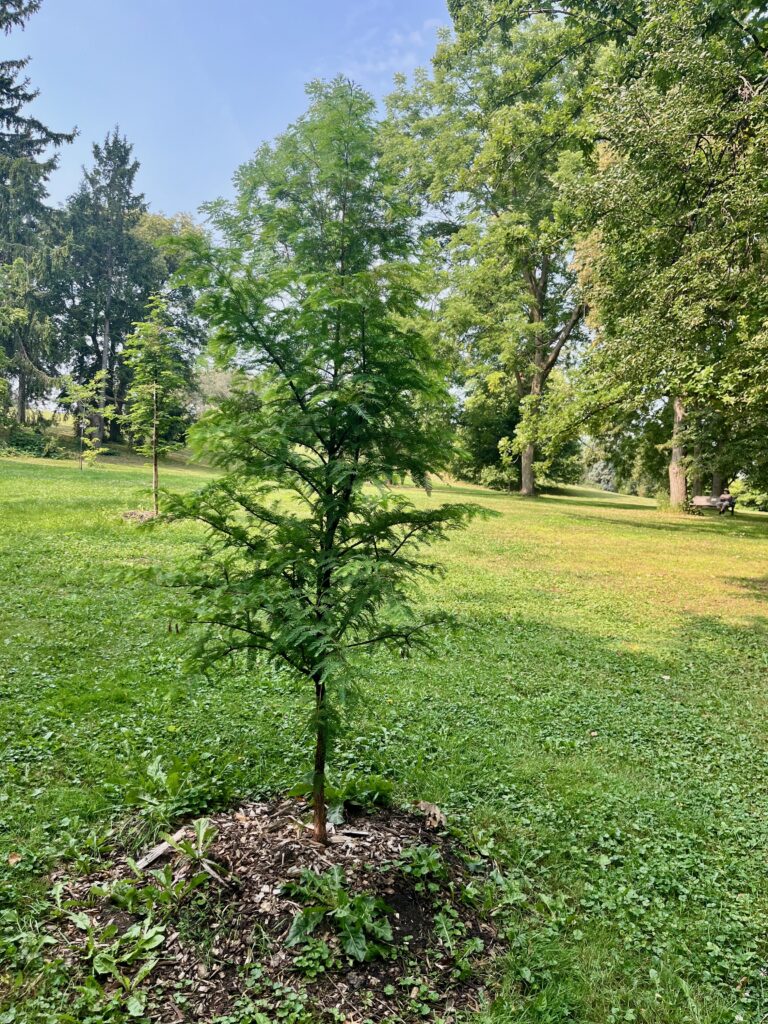
Jade Prince Dawn Redwood—Metasequoia glyptostroboides ‘Jade Prince’—Jade Prince is a cultivar of the Dawn Redwood (see Dawn Redwood species description) with slightly more compact and evenly spaced branching and beautiful fall colours. Although the tree can grow to 45 metres height in rainforest conditions, it will grow to about 25 metres tall in Ottawa. This tree is located in the middle of the northern part of the Arboretum, about 20 metres east of a bench.
Korean Sun Pear—Pyrus fauriei ‘Westwood’—This is a small ornamental pear tree native to Korea. The tree has a compact rounded form and is very cold hardy. The flowers and fruit are quite small, but they are attractive as they appear in masses on the tree. The Korean Sun variety was selected for its attractive autumn colours of red, yellow, and orange. The tree can grow to a little over 5 metres tall. This tree is located along the path at the north end of the Arboretum, about 60 metres east of the point where the path meets Prince of Wales Drive.
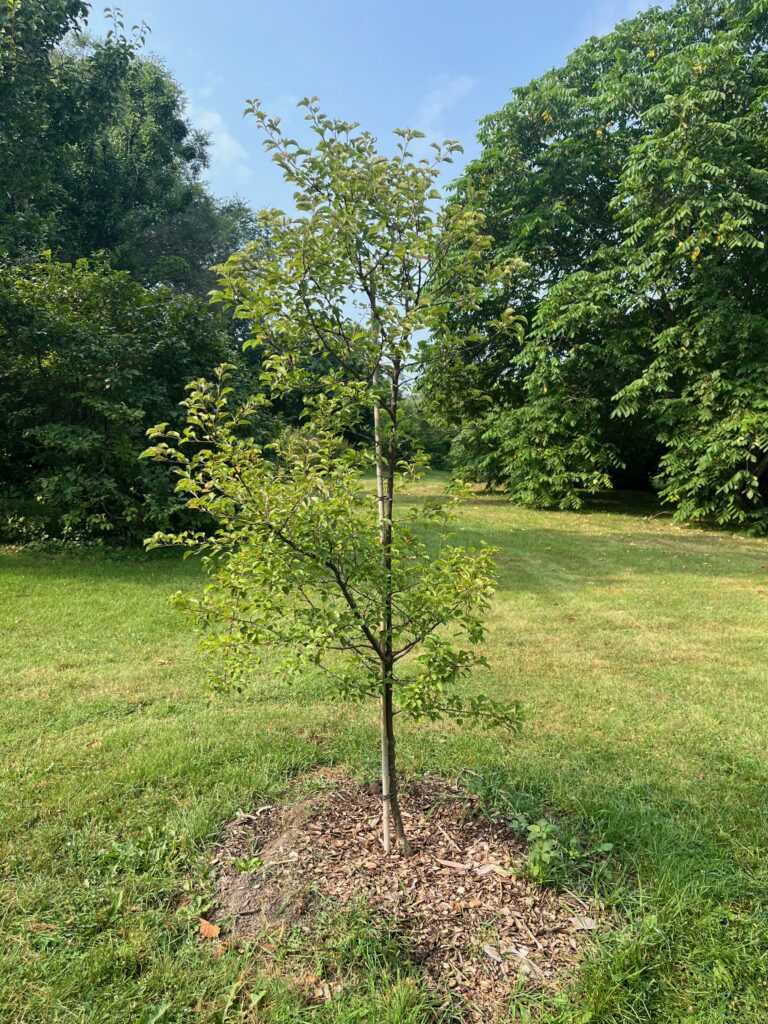
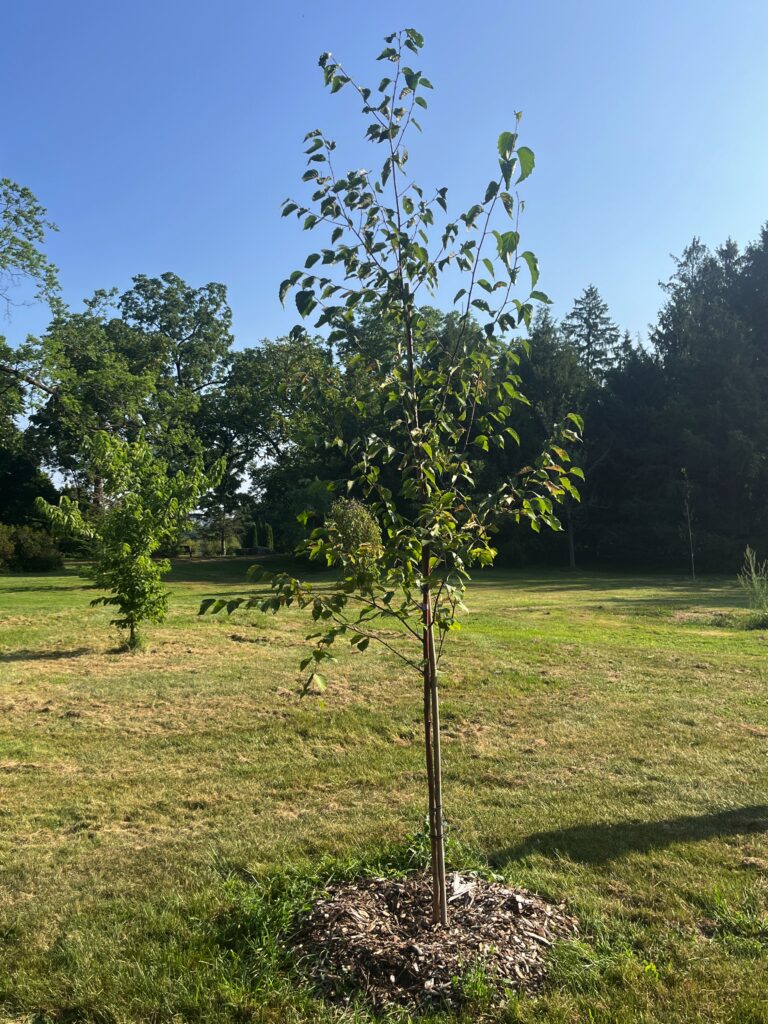
Paper Birch (1)—Betula papyrifera—Paper Birch (or White Birch) is the iconic tree of the north, ranging from sea to sea to sea in Canada. All Canadians know of its use by the indigenous people in canoes, baskets, bags, and other essential things. It’s a pioneer, one of the first trees to grow back on disturbed sites. The bark starts out a dark red colour, turning white after several years. The fall leaf colour is bright yellow. The tree can grow to 20 metres tall. This tree is located about 100 metres south of the bench in the Arboretum circle, about 25 metres west of Paper Birch (2).
Paper Birch (2)—Betula papyrifera—Paper Birch (or White Birch) is the iconic tree of the north, ranging from sea to sea to sea in Canada. All Canadians know of its use by the indigenous people in canoes, baskets, bags, and other essential things. It’s a pioneer, one of the first trees to grow back on disturbed sites. The bark starts out a dark red colour, turning white after several years. The fall leaf colour is bright yellow. The tree can grow to 20 metres tall. This tree is about 100 metres south of the bench in the Arboretum circle, about 25 metres east of Paper Birch (1).
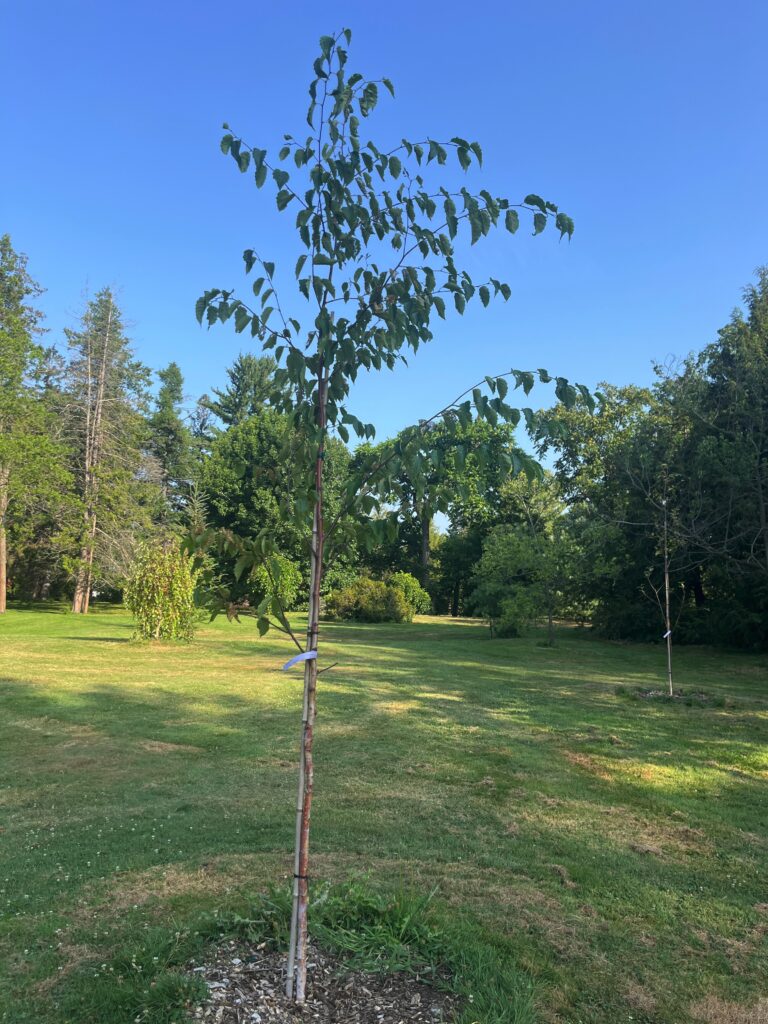
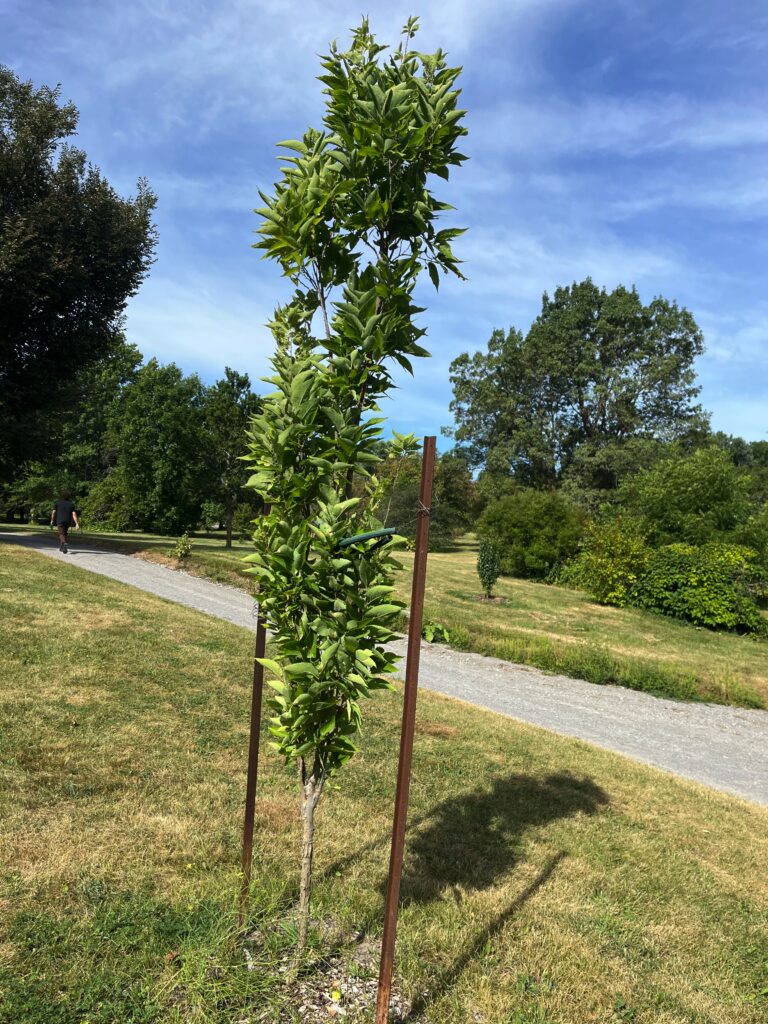
Prairie Sentinel Hackberry—Celtis occidentalis ‘Prairie Sentinel’—Hackberry is a native North American tree that just barely made it into Canada at Ontario’s southern tip. Yet it can survive extreme conditions of cold and drought and is now being planted extensively in Canadian cities. Prairie Sentinel is a fast-growing cultivar that was cloned from a tree found in the United States prairies. It grows into a tall columnar form. The leaves turn yellow in the fall. The tree can grow to 20 metres tall. This tree is located right at the southwest corner between the lowland path and the south path.
Redmond Basswood—Tilia americana ‘Redmond‘—Basswood is often found in local hardwood forests along with maple, beech, and birch trees. It grows quickly into a tall tree with many large leaves providing lots of shade. Its flowers, seeds, and leaves provide food for wildlife. The Redmond variety of Basswood has dense branches that are slightly more upright than the species form. The tree can grow to 20 metres tall. This tree is located between the two south paths, in an open area that is right at the bottom of the hill.
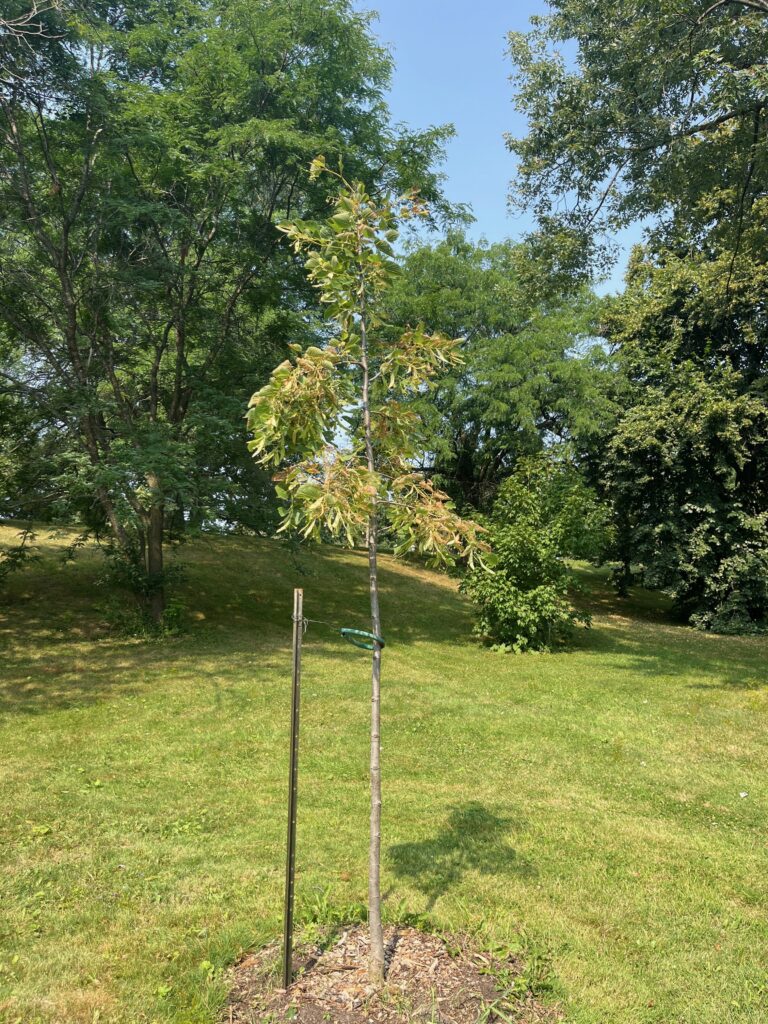
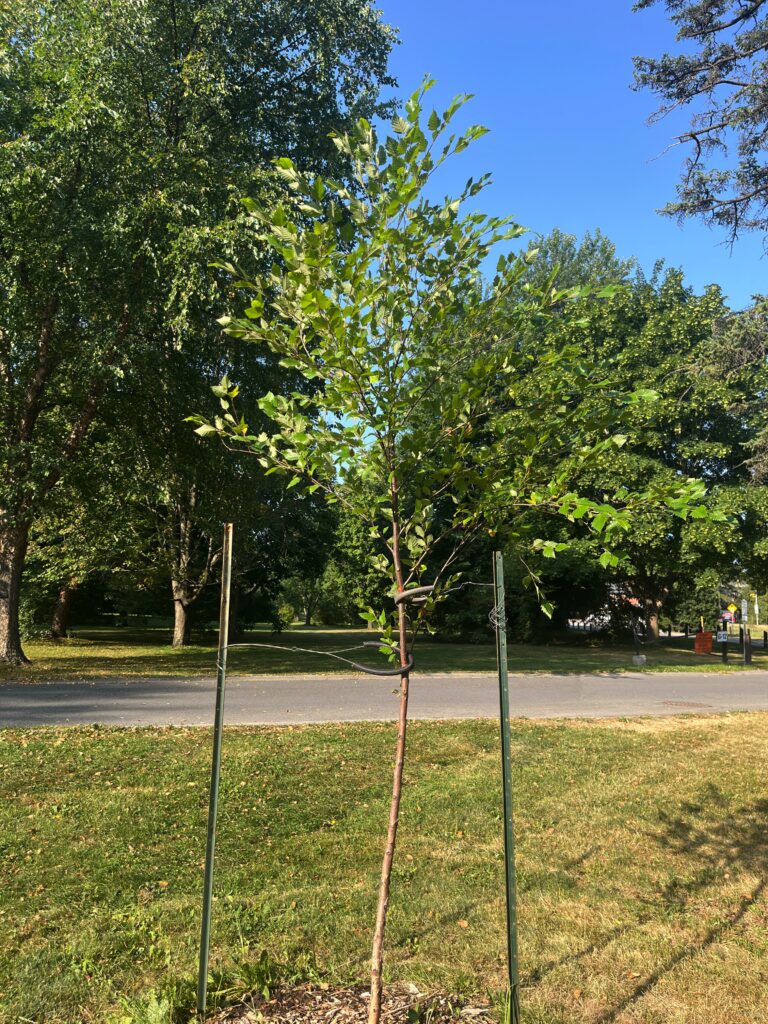
River Birch (1)—Betula nigra—Although the normal range for River Birch is south of the Canadian border, its cold hardiness and heat tolerance suit Ottawa conditions well. It’s also resistant to pests including the bronze birch borer which plagues other birch species. River Birch is an attractive round tree with very interesting bark that peels to show a pink salmon colour on the branches. The tree can grow as high as 20 metres. This tree is located just inside the Arboretum Circle Road, about 15 metres along the road from where the entrance road turns right to follow the Arboretum circle road.
River Birch (2)—Betula nigra—Although the normal range for River Birch is south of the Canadian border, its cold hardiness and heat tolerance suit Ottawa conditions well. It’s also resistant to pests including the bronze birch borer which plagues other birch species. River Birch is an attractive round tree with very interesting bark that peels to show a pink salmon colour on the branches. The tree can grow as high as 20 metres. This tree is located across the Arboretum circle road and about 20 metres south from River Birch (1).
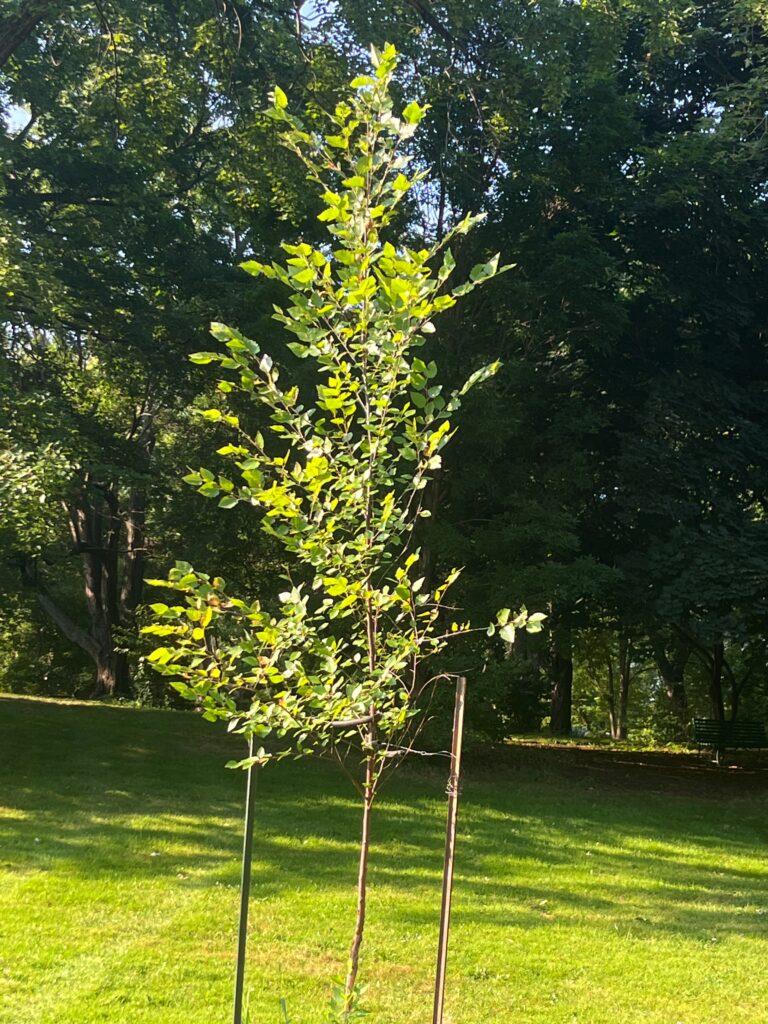
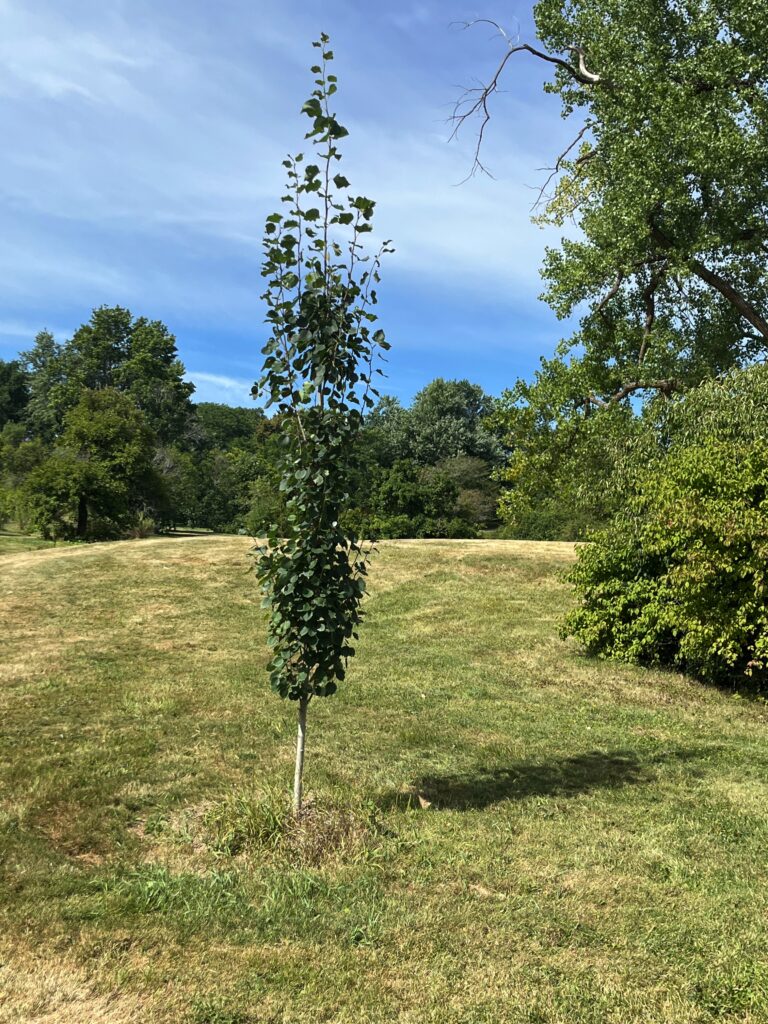
Upright Eurasian Poplar—Populus tremula ‘Erecta’—This tree is a cultivar of a very widespread poplar species. Eurasian Poplar is nearly identical to its North American counterpart, Trembling Aspen, and is just as cold-hardy. The Erecta form is distinctively narrow and tall. Since it’s a male clone, it doesn’t produce the cottony seeds that sail from poplars in the spring. The leaves turn bright yellow in the fall. The tree can grow to 10 metres tall. This tree is located 25 metres west of the lowland path, and 20 metres north of the path that splits off the south path and comes down the hill.
Wildfire Black Gum—Nyssa sylvatica ‘Wildfire‘—In Canada, Black Gum grows only in the most southern part of Ontario. The species grows all the way down to the Gulf of Mexico (and into Mexico) where it’s called ‘Tupelo’ and its nectar is used by bees to make honey. The tree leaves have beautiful red-purple fall colours. The Wildfire cultivar has a nice form and bright red leaves in the spring as well. The tree can grow to 20 metres tall. This tree is located inside the Arboretum circle road, about 30 metres southwest of the North Lookout parking area.
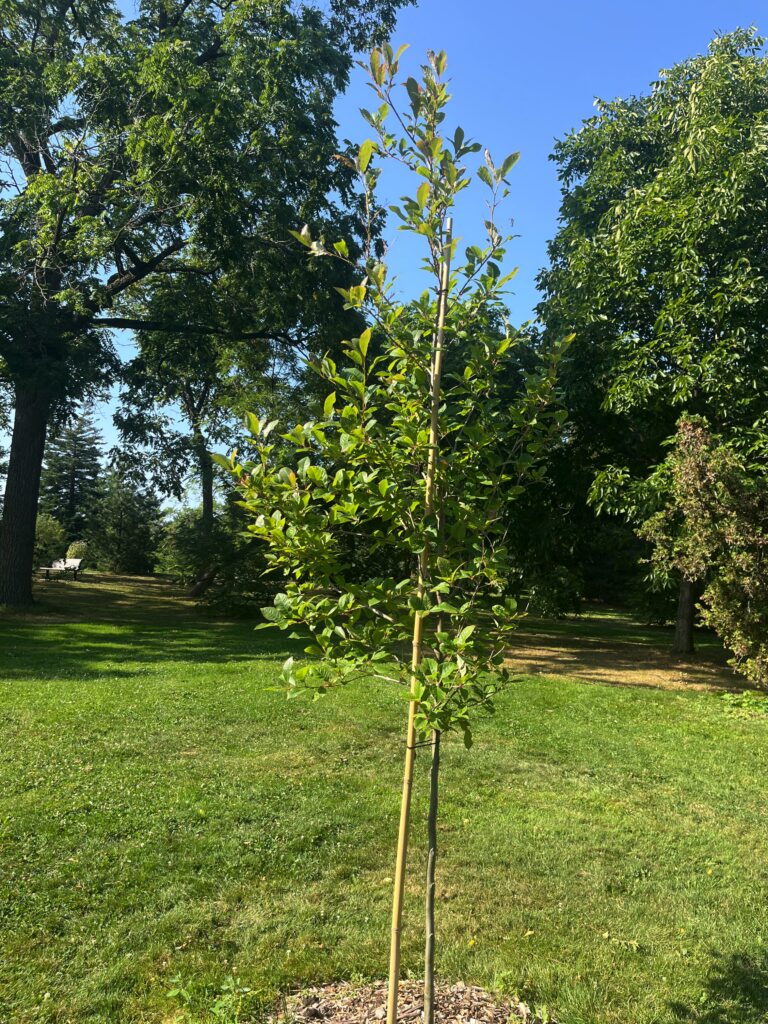
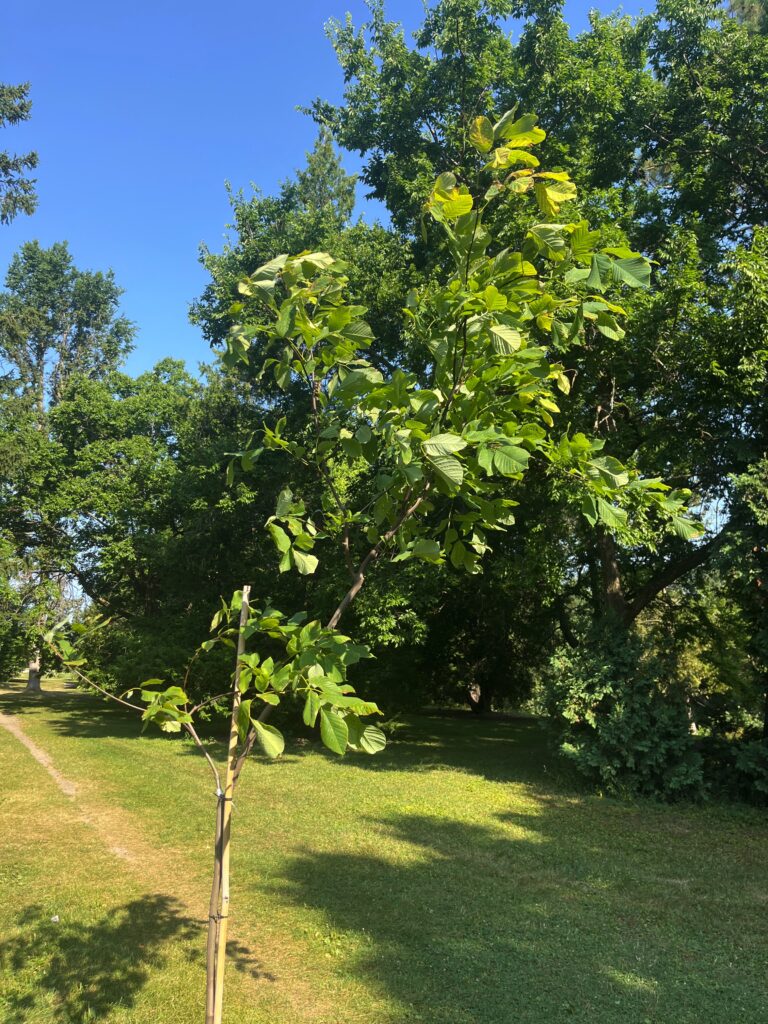
Yellowwood—Cladrastis kentukea—Yellowwood is native to the southeastern United States, although is rarely found there. Yet it is hardy much further north and deserves to be planted here more often. The tree is known mostly for its pretty white clusters of blossoms in spring and clear yellow leaves in the fall. The mature bark is smooth and gray, like a beech. The tree can grow to 15 metres tall. This tree is located on the outside edge of the Arboretum circle road, about 50 metres east of where the road turns into Building 72.
Zumi Crabapple—Malus ‘Zumi’—The Zumi crabapple variety is a naturally-occurring hybrid that is often used for rootstock due to its salt tolerance and drought resistance. Several cultivars of this crabapple tree are also propagated and sold commercially. It’s known for its fragrant white flowers in the spring as well as its glossy fruit that attracts many birds. The tree can grow to about 5 to 10 metres tall. This tree is located near the parking lot at Building 72, just 25 metres west of the northwest corner of the lot.
